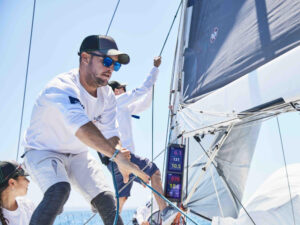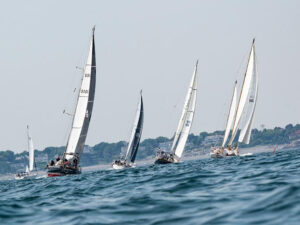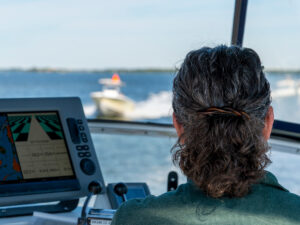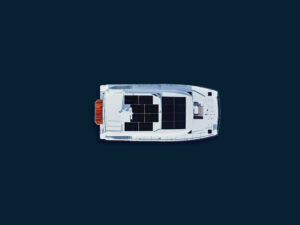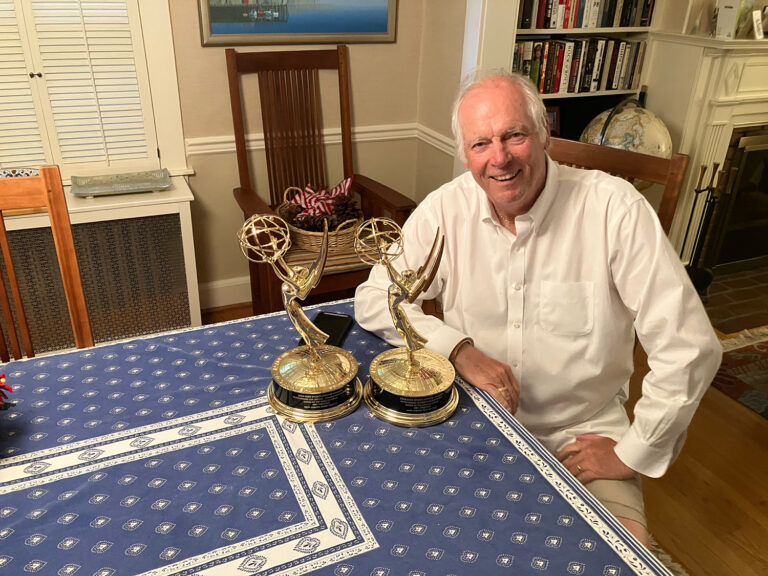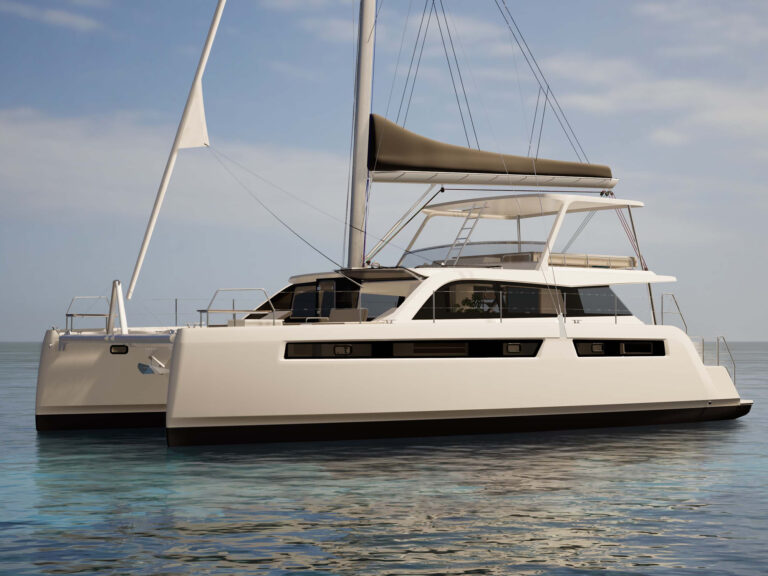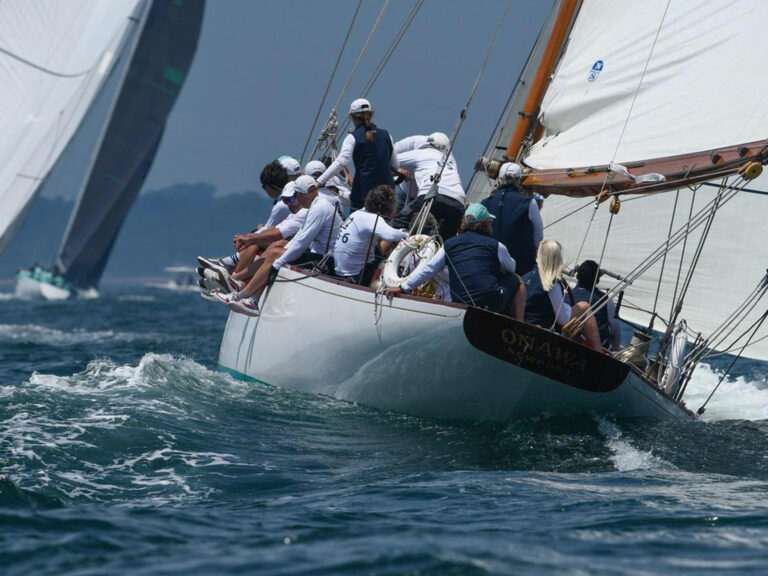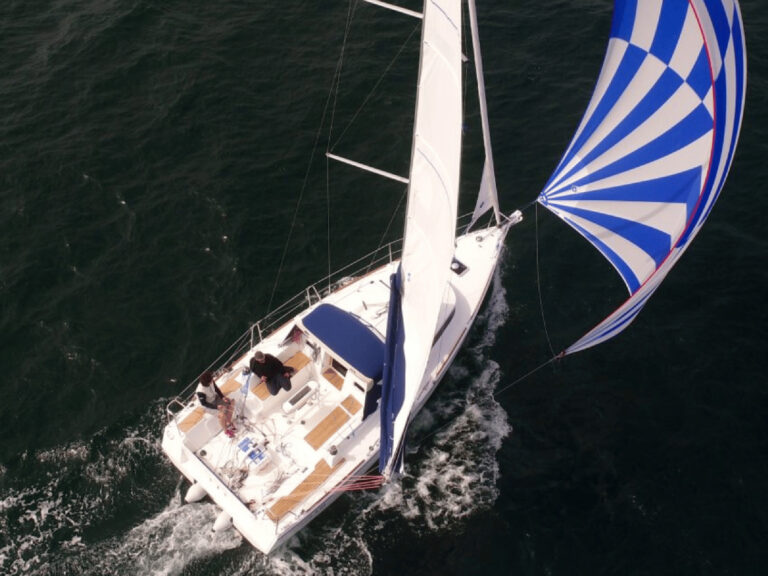Sometimes cruising is about boats and passage-making. Other times it’s about using the vessel as a base camp, taking off, and exploring new territory on foot. With Ithaka safely docked in Cartagena, and after we bolted from Maracaibo, Venezuela, in the midst of the massive strike that is shutting down the country and threatening the Chavez government, we headed south to Cuzco, Peru, on the eastern slope of the Andes.
| | A shepherd with one of her baby alpacas* * *| Perched at 11,150 feet above sea level, this is one of the most spectacular Spanish colonial cities in South America. Founded by the Quechua Indians in 1100 and considered by them to be the energy center of the earth, in the early 16th century Cuzco was overrun by the Spanish conquistadors who destroyed as many of the infidel temples as they could. However, in a perfect symbolic irony, on those great stone foundations, they erected their forts and cathedrals. Here, Douglas and I have spent our time visiting ancient Indian holy sites, setting off on rickety bus adventures from one mountain village to the next, eating alpaca burgers, and bundling in our fleece to ward off the high-altitude chill.
A couple of days ago, Douglas set off on foot, along with other intrepid types, to trek the famous Inca trail, up into the mountains to the ruins of Machu Picchu, the Inca Mecca perched on the top of a distant peak. In a few days, Ill take off too, by train for Aguas Caliente, the frontier town at the foot of the mountain. We plan to rendezvous at the top.
| | Bernadette in an Inca doorway* * *| Tonight, though, Im alone, and I stroll to one of my favorite restaurants, the _El Colbri_, (hummingbird) where I take the table on the second-floor balcony overlooking the _Plaza de Armas_, Cuzcos main square. Before me are flower gardens and fountains, churches and balconied colonial buildings, their organic Inca stone bases topped by ornate Spanish buildingsa wild architectural fusion. Beyond the plaza and the cathedrals citadel towers, with the carved saints looking down on the city, are the Andes, stretching above it all. In the distance lightning illuminates the broad-shouldered mountains framing the town. The Quechua call the revered mountains embracing Cuzco _Pachamama,_ earth mother. On a balcony across the way from mine sits a group of twentysomethings, their lives stretched out before them_._ I sip my wine, 20 years behind these young backpackers, but in the middle of my own adventure nonetheless. Better late than never.
| | Night lights on the Plaza de Armas in Cuzco* * *|
Douglas and I have spent many hours in the buildings around this plaza, admiring the intricate gold altars, soaring statues, and colonial paintings. One of the curious aspects of these monuments to the successful brutality of the Spanish conquistadors and their Inquisition is found in the details of the religious carvings and paintings in the churches. From a distance they look typically 15th and 16th century European. But on closer examination, the Quechua artists included exceptional details that in the midst of oppression bring their own world to life. In a giant painting of The Last Supper, for example, Marcos Zapata, a master Quechua painter, resisted the idea that Jesus, who was being imposed as his new God, looked like the orejones, which means “big ears,” their name for the Spanish conquistadors. Zapata felt that for an event as momentous as the last supper, the Jesus he understood would never have eaten such common fare as lamb, so he created a mammoth canvas depicting the most magnificent final feast he could imagine. His darker Jesus and Apostles are portrayed with great platters of papaya, yucca, and roasted guinea pigs, the ceremonially appropriate fare.
| | This three-foot-tall hand-carved stone, with 12 angles, shows the masonry skills of the Quechuas. Every joint is perfect.* * *| The sacristy of _La Catedral_, started in 1559, and taking 100 years to build, stands today as one of the finest examples of the Cuzco School of painting. It combines European painting, rococo, and contemporary Andean talent, and the results are astonishing. The angels carved in the wood choir of the cathedral, known as one of the most beautiful choirs in the world, are all visibly pregnant and bare-bellied; they resemble the Inca women of the day. Under Catholicism, the Quechua were no longer allowed to worship the mountains and sun, so over and over again, their artists painted a mountainous Virgin Mary, her large robe draped out to the sides, and a white mantilla over her head and shoulders, like snow capping the peak. Around her head theres always a gold orb with giant sun beams. They had to accept the Virgin Mary or die, so they made her into their own _Pachamama_mother earth, who remains a powerful figure in Quechua mythology and daily life, even today.
| | A stained-glass dome from Lima, the capital.* * *| The architecture and cultural legacy of the Quechua Indians, (who are often called Incas, although Inca actually was the title of their leadersimilar in essence to Caesar) is what Ill remember most about Cuzco and the Sacred Valley. Their major buildings were constructed of gargantuan carved stone, strong enough and intricately connected to withstand the great earthquakes that torment the region. These stones had to be hauled up miles of mountains, across broad rivers, and over terrain that would daunt the most aggressive bulldozer driver. You still couldnt fit a razor blade between the joints of the 600- and 700-year-old stonemasonry.
| | Douglas at an Inca ceremonial fountain at Ollantaytambo* * *| Although theres no written documentation of pre-colonial times, its assumed from oral history and religious customs that the Quechua Indians built these superhuman structures without using slaves. The people paid their taxes to the Inca in labor, and working on holy sites was considered a sacred privilege. When the Spanish conquistadors arrived, they found the Quechuas religious depictions of solid gold condors, pumas, and serpents. Pizarro and his friends stole everything they could get their hands on, melted the majority into ingots and split the booty, delivering to the Spanish crown its usual 20 percent cut. With modern weapons and horses, along with the introduction of smallpox and syphilis, within 50 years, the Spanish had crushed the power of the Incas empire, an area that at one time stretched across what we now know as major portions of Ecuador, Colombia, and southern Chile, down to the Amazon, and to the shores of the Pacific.
Over our days in Cuzco, Douglas and I rode local buses from town to town through the Sacred Valley, sometimes lulled by delicate Andean music played on bamboo pan flutes. We watched Quechua women in colorful outfits jumping on and off the bus selling bags of popcorn, fried plantain chips, red jello, and sweet cornbread steamed in husks. We headed out to the bustling market in Pisac, where everything is sold: vegetables, pigs, trinkets, carvings, artifacts, chickens, and beautiful traditional mantas. All around us were the Andes, their stepped agricultural terraces still farmed today by Indians living in the mountains. At ascending altitudes, the Indians’ terraces fall into different agricultural microclimates, and for hundreds of years the Quechua have successfully experimented with diverse crops, determining what grows best as you climb closer to the condors.
| | Waiting for customers at the San Pedro market in Cuzco* * *| We walked to the Cuzco markets, where tittering women wearing little regional fedoras perched on top of their headstheir two long black braids knotted together in the backsold every kind of corn you can imagine, fresh _ceviche_, splayed roasted pigs, and arrays of fresh vegetables and tropical fruits. We bought plenty of fresh food there, but the local restaurants were so inexpensive that mostly we ate out. A three-course dinner in La Colibri, for example, cooked by a French/Peruvian chef, was about $4.25 including wine. Guinea pig is still offered in lots of restaurants, as are Andean favorites like grilled beef hearts on skewers, alpaca steak, and sweetly potent pisco sours. Pisco is a local brandy that is combined with lemon juice, sugar, and whipped egg whites. Always theres a pot of coca tea, a calming brew made by steeping dried coca leaves in boiling water. Everyone drinks it for at least a few days to help acclimatize to the high altitude; were so high, in fact, that Ive had nosebleeds for the first time in my life.
One day, Doña Juana Maria, who owns the Hostel Amaru, the pretty hotel where we’re staying, invited us to join her family in a party they were putting on for the street children of Cuzco. We happily spent the evening before distributing invitations to all the raggedy little kids selling candy and postcards in the square, and the next day watched hundreds of urchins march up the street. At 10, the doors of Hostel Amaru opened, and into our courtyard streamed a beggar’s opera. We passed out pastries and hot chocolate (they got to keep their plastic cups). Each child was given a small present, funded by the hostel guests and Doña Juana. We sat and talked and drank our cocoa together—hundred of kids, two Germans, two Brits, two Americans, and the doña’s family—and for the first time this season I felt a Christmas spirit. Since that afternoon, whenever we walk through the plaza, the kids all call out to us, “¡Hola Señorita BB! ¡Hola Señor Doo-glass!”
| | Children came from all over town for the Christmas party at Amaru. This child wears a traditional manta and the hat of her region.* * *| One day, we hopped the bus to Urubamba, where we hiked up the mountain to the salt flats that have been in continuous use since the Quechua built them more than 500 years ago. Getting up there was a lung buster, and for a while I didnt think Id make it, until a little Quechua woman, probably 60 years old, sprinted past me. Instilled with a new determination, I persevered. When we arrived at the top, stretched out below us on the opposite side of the mountain were countless snow-white salt terraces and workers of every age, their legs caked to the calves with a dry white powder, each working a wet salt flata grueling way to make a living, but they were proud of it. At the foot of the mountain, now looking like a tiny rivulet, was the powerful Urubamba River, teeming with _trucha_ (trout). Around us, ethereal white clouds shrouded the shoulders of the mountains. Tucked here and there, the poorest of the Quechua still live in caves and work the salt flats.
| | Bernadette up at the salt flats* * *| After Douglas set out on the Inca Trail, I signed on for a whitewater rafting trip on the Urubamba, whose rapids were rated as grades three and four, out of five. I figured I could handle that better than the four-day, uphill trek to Machu Picchu. With my heart condition, I was worried Id be too slow and hold Douglas and his group back. I pushed him to go without me, as I know how much he loves to hike, and I wanted him to enjoy the trek at his own pace.
The morning of my rafting expedition, I was picked up at my hotel at 9 by an Israeli named Len; I jumped into his car with two other rafters, Peter and Bill, a Kiwi and a Brit. We sped over mountain roads into the Sacred Valley to meet the five other members of our team at the river. When we got closer to our rendezvous town of Ollantaytambo, we found that heavy rains had closed the road. This was a problem, as the other part of the team had the raft, the safety kayak, and the safety-kayak operator. What to do? We talked about it with Len, who is the unfazed type. He had another raft in the back of the van, he said. All we had to do was blow it up. We were awfully light with only four people, but he decided we looked strong enough to handle it. (Why, I dont know. We looked like deer in the headlights at that point.) Buoyed by his confidence, we plunged ahead.
We hauled out the raft, blew her up with a hand pump, pulled out full wetsuits, stripped off and put them on, buckled on helmets and life jackets, and set off. At first, everything was calm and lovely, except for the bloated animal carcasses we passed. Inca ruins were on the mountains surrounding us, and the river moved us at a good clip. Immediately Len taught us how to coordinate our rowing and keep one foot wedged under the foot brace on the inflated floor of the raft. We practiced commands wed need when the river got more complicated: Forward (everyone rows in sync), forward left (used for turning, the two on the left row normally, the two on the right row backward), forward right (opposite to forward left), stop (catch your breath and rest for three seconds), and high side (quickly throw yourself to the side of the raft thats caught on a boulder before the raft flips over into the whitewater).
|
| | Long-necked ceramic statues have been made for generations in Cuzco by the Mendivil family. Dolls are sold on every street corner, made by the women from their weaving scraps.* * *|
Within 20 minutes, I understood why another few bodies wouldve been a good thing. Rowing in roiling whitewater was tough with only four of us, and my shoulder muscles burned from the endless long strokes. As the water became more powerful, and the boulders and drops larger, Lens commands came faster and more furiously. ¨Forward left! Forward right! High side, high side, HIGH SIDE! OK, forward, forward, FORWARD!” At first we had some frightening screw-ups with the forward lefts and rights, which almost dumped us, but Len was as focused and unforgiving as a laser. We learned quickly.
| | Most Quechua women still wear the traditional clothing of their region.* * *| At one point, we hit some mammoth rapids, slalomed over a cliff, and took torrents of whitewater over the raft and us. Peter, the Kiwi who was across from me at the front of the raft, was half swept overboard. Only his foot in the floor strap connected him. His head and upper body were underwater and he flailed his arms wildly, still holding onto his oar. Terrified in the chaos of the churning water, I somehow reached over, and hauled his 200 pounds back aboard. There wasnt a second for glory, though, as we flew over another white waterfall cliff, waves hit the raft in torrents, and Len continued yelling, “Forward, forward, FORWARD!” That was a moment when risking a heart attack on the Inca Trail seemed a better option.
We got through that rapid, and another and another and another. Hour for hour, it was one of the most taxing and exhilarating experiences of my life. By the end of the day, we were a team, and I was rowing as well as the guys. Len had even complimented me (one lives for the approval of 23-year-old guides). This caused Bill, now opposite me on the raft, to row even hardermachismo having the same effect the world over. Finally, we reached a long stretch of calm water, and on the bank was the van, waiting to take our quivering muscles back through the mountains to Cuzco. Len told us, before we all fell fast asleep on top of each other and all the gear in the back of the van, that parts of the river, swelled from the recent rains, had been a grade five.
| | In the markets, we found beautiful mantles for sale, woven by the women, and worn by the Quechuas as protection from the cold, as well as for carrying babies and belongings. This one celebrates the traditional Inca icons of pumas, condors, serpents, the evil eye, the river, and medicinal flowers.* * *| As we bounced along the mountain road, I imagined Douglas out there somewhere, trekking up toward the pilgrimage site of Machu Picchu. Tomorrow morning at 6:30, Id climb onto the blue and yellow _Perurail_ train and take the four-hour journey along the banks of the Urubambawith which I now had a bondto _Aguas Caliente_, the little frontier town at the foot of Machu Picchu. I couldnt wait to meet him at the top, tell him about the river, hear all about the trail, and together see one of the wonders of the ancient world.
e-mail the Bernons: [email protected]

